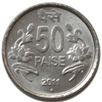India | |
| Value | 50 |
|---|---|
| Mass | 2.9 g |
| Diameter | 19 mm (0.75 in) |
| Thickness | 1.5 mm (0.06 in) |
| Edge | Reeded |
| Composition | Nickel (1957-1971) Cupronickel (1972-1990) Stainless steel (1988-2016) |
| Years of minting | 1957–2016 |
| Mint marks | Mumbai = ⧫ Mumbai Proof issues = B Hyderabad = * Noida = ° Kolkata = No mint-mark |
| Circulation | In circulation |
| Catalog number | KM#398, KM#374 and KM#70 to KM#55 |
| Obverse | |
 | |
| Design | State Emblem of India with country name |
| Reverse | |
 | |
| Design | Face value and year flanked by National flower of India |
The Indian 50 paisa coin, popularly called Athanni, is a denomination of the Indian rupee, equal to half a rupee, that is very rarely found in everyday circulation. Currently it is the lowest circulating denomination of the Indian rupee. The symbol for paisa is ( ![]() ). On 30 June 2011, when the 25 paisa and all other lower denomination coins were officially demonetised, the 50 paise coin became the lowest circulating denomination of the Indian rupee. [1]
). On 30 June 2011, when the 25 paisa and all other lower denomination coins were officially demonetised, the 50 paise coin became the lowest circulating denomination of the Indian rupee. [1]

